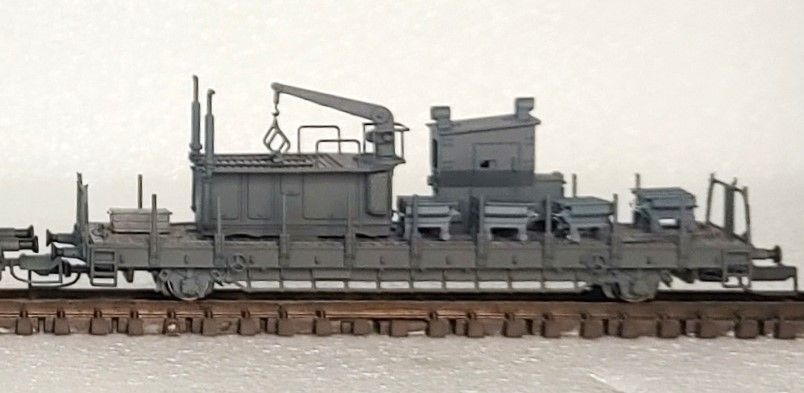Eisenbahngeschütz K5
Railwaygun K5 Leopold
Railway service and transport
The transport of the 28cm Cannon 5 (E) was different. On the one hand, these cannons were driven in a separate train with construction material, on the other hand, if the gun was used on a "Vögele" turntable, a second train was required. In addition to the gun, the gun train included a temperature control car, at least two bullet and cartridge cars, a fire control car and at least one accessories and tool car. Escorts in the form of an anti-aircraft car were often provided.
The equipment mostly arrived at the site using class 50 ÜK locomotives (Transitional war locomotive)

and class 52 were also used.
A diesel locomotive or smaller steam locomotive was responsible for the shifting The small steam locomotives were almost exclusively the region`s bag locomotives. The diesel locomotives were the V20, V36, D311/V188 ( V188 was only used for pushing, but not for transporting the K5). These gun trains never pulled diesel or electric locomotive. They wanted to be free from possible attacks on the overhead line and independent of various power systems.
Personnel transport vehicles were installed on all trains. Additional cars for motor vehicles and spare parts for the turntable and cannon were also found in different versions in all gun platoons. These cars were mostly older ones from all over Europe from Rra 1. This also affected the team cars, which wee no longer expected tobe used in everyday life. ( That will have to be enough for the soldiers...) The shooting generally took place without attached wagons and without a locomotive.The brakes, which were tightened by hand, absorbed the recoil. The recoil was so powerful that the gun dragged backwards along the rails or a few meters if they were not otherwise secured.
The color scheme of the K5 was a darker armored grey, and there was no known photo credit showing either the national emblem or the bar cross! A camouflage version and a light gray color are not documented.
A special feature before shooting was that the rear bogie was pulled back by around 1.9m to create space for the returning pipe. Loading was done with the help of a loading crane. rough and cart. The rammer worked in such a way that the guide ribs of the bullet were "threaded" into the rifling of the barrel. After the shot, the case catcher swiveled behind the barrel to catch the ejected cartridge case. The propellant charge consisted of the main cartridge (case) and three primary cartridges (bag). The xplosive chatgeweighed around 30Kg. Th ammunition supply was very complex: each gun equired an ammunition, cartridge and temperature control carriage. the latter was connected to the cartridge cart by hoses. in the firing position, bridges wer laid between the ammunition feeder wagons and the cartridge and ammunition wagons. the feeder truck then carried the ammunition to the gun. where a crane lifted the loaded troughs onto the gun`s loading cart.
During transport, these electrical units were located on the ammunition feeder car

while they were pushed onto the rear bogie in the firing position.
The firing range when using the standard explosive projectile was up to 62km with a large load and a v0=1.128 /s.A long-range expert commission ultimately relied on a project that Wernher von Braun`s team had developed at Peenemünde Army Research Institute: the "arrow bullet" . With this arrow projectile co- developed by the Röchling company, firing distances of up to 127.5km could now be achieved at an initial speed v0= 1.420m/s. During test shooting at the army artillery firing range in Rügenwalde / Pomerania, the maximum firing range was approx 150Km !
a.s.modellbahn is working o finally offering our customers a K5 (the commercially available K5s, in N gauge, are unfortunately not mobile in an integrated transport set) with ammunition feeder wagons (not yet commercially available) for exemplary rail transport.
References:
- German railway guns, Gerhard Taube, Motorbuch Verag
- heavy gun and railway guns olumes 1-3, Franz Kosar, Bernard Graefe- Verlag Munich.
- German railway guns, 15-80cm caliber, Joachim Engelan, Podzun_Pallas Verlag
- German RailroadGuns n action, Bruce Culver and Don Greer, squadron/ signal publication
- Giant guns and heavy brummers, Rudolf Lusar, Bernard & Graefe- Verlag.









